How to Get Simcity 4 to Work on Windows 10
10 ways Android and Windows 10 can work well together
You can sync reminders between an Android device and a Windows 10 PC, share files and more — if you have the right apps.
If you regularly use a Windows 10 PC and an Android phone or tablet, there are several Android apps you can install that can seamlessly link the flow of information between the two. For instance, you can start a quick note on your phone, then finish it later on your Windows 10 PC, or you can receive the same alert on both devices for an appointment.
The following Windows 10-friendly Android apps are all from Microsoft — and all free. To get the kind of interoperability described above, you need to be signed into each of the apps on your Android device with the same Microsoft online account you use to sign into your Windows 10 computer.
1. Cortana: Sync reminders between your Windows PC and Android device
The Cortana app for Android lets you create reminders that will sync with, and send notifications to, your Windows 10 PC. To set a reminder in the Cortana app for Android, tap the three-dot icon on the upper-right of the app's main screen, tap Reminders, tap "Remember to…" on the next screen, and enter a name for your reminder to the right of the circle icon.
Then you can tap "Set a time" to set the time when you want to be sent a notification for this reminder. You can also enter a destination (by tapping "Set a place") that will trigger the notification when you physically arrive at that location with your phone, or add an image to the reminder ("Add a photo").
 IDG
IDG Reminders set in the Cortana Android app (left) will appear on your Windows 10 PC, including in the Start menu (right).
Once set, this reminder will sync with your Windows 10 PC; for example, if you have the Calendar app pinned as a live tile on the Start menu, the reminder will appear on the Calendar app's tile. And when you click the time/date icon on the notification area of Windows 10, the reminder will appear listed on a side panel below a calendar.
And, yes, this works in reverse: You can set reminders on your Windows 10 PC (either through the Calendar app or Cortana) that will show up on your Android device via the Cortana app.
2. OneDrive: Access files on your Windows 10 PC with your Android device
You probably already know that Windows 10 comes with Microsoft's cloud storage service, OneDrive, which is integrated deeply into the OS — it shows up as a folder in the File Explorer. Dragging documents, images or other types of files to it automatically uploads them to the cloud.
The OneDrive Android app lets you view documents or images stored in your OneDrive folder. (If you tap an image file or PDF in your OneDrive cloud folder, the OneDrive app will load it in its own viewer. If you tap a document, like a plain-text file or Word document, the document will be downloaded to your Android device and the default app that you use to view this document format will load it.)
You can also set the OneDrive app to automatically upload photos and videos that you capture with your Android device's camera to your OneDrive folder. You can then access these photos and videos on your Windows 10 PC.
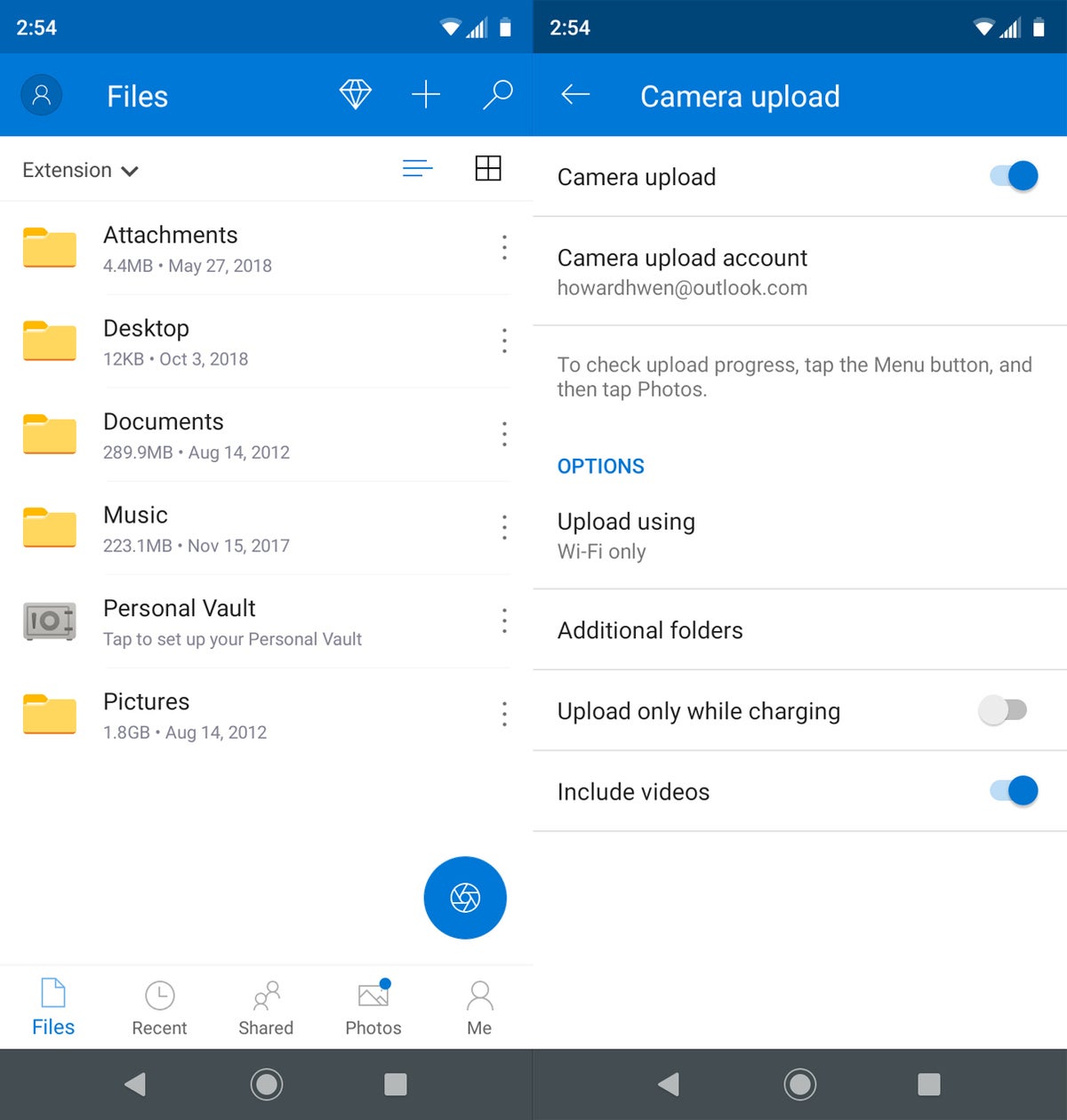 IDG
IDG The OneDrive Android app gives you access to documents and images in your OneDrive cloud storage (left). You can also have the app automatically upload photos and videos from your Android device to your OneDrive cloud storage (right).
To enable automatic upload from the camera (or to make sure it already is enabled): In the Android app, tap the Me icon on the lower-right of the main screen, tap Settings, and tap "Camera upload" on the next screen. There are also options for uploading only via Wi-Fi, uploading only while the Android device is plugged in to charge its battery, and including or excluding videos from automatic uploads.
3. Outlook: Sync calendar events between your Windows 10 PC and Android device
Obviously, the Outlook Android app is primarily meant for accessing your email from Microsoft services such as Exchange, Office 365 or Outlook.com. (It can be used with your Gmail or Yahoo Mail account, too.) But the Outlook app also has a calendar tool that syncs with the Calendar app on your Windows 10 PC — through it, you can enter appointments and reminders of things to do on days and times you pick. Both your Android device and your Windows 10 PC will send you alerts as event deadlines approach.
 IDG
IDG Events that you create in Outlook on your Android device (left) will appear in the Calendar app on your Windows 10 PC (right).
On the Android app, you get to this calendar tool by tapping the third icon along the bottom of the main screen. (It looks like a page from a daily calendar, showing the current date.) Then you tap on a day you want to mark with an event reminder (by scrolling vertically through a list of dates below a portion of the calendar at the top of the screen).
Next, tap the "+" button on the lower-right of the screen. On the next screen for setting a new event, you pick the time, enter a location for the event, and set how far in advance you'll receive the alert. You can also add the people from your contacts list you want to receive notifications about the event.
Like setting reminders with the Cortana app, this works in reverse. If you set appointments or events in the Calendar app on your Windows 10 PC, you will get alerts on your Android phone through the Outlook app.
4. OneNote: Sync notes from your Android device to your Windows 10 PC
A Windows app version of OneNote is included with Windows 10. Installing the OneNote Android app on your mobile device can be handy for creating notes while you're on the go that you can edit more thoroughly later on your Windows 10 PC.
With the Android app, you can make notes or to-do checklists by entering text for them through your Android device's touchscreen keyboard, handwriting with a digital pen, or voice-typing. You can draw doodles on your notes with your finger or digital pen, and add photos to a note with your Android device's camera.
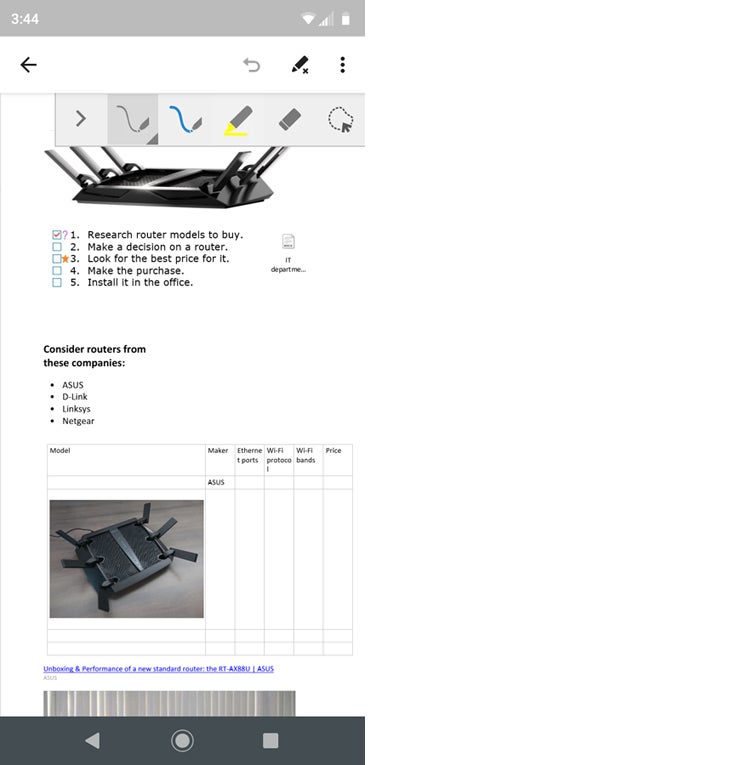 IDG
IDG Draw on your notes with a finger or digital pen in the OneNote Android app.
5. Your Phone Companion: Manage your Android phone notifications, pictures, text messages, and make voice calls from Windows 10
You can have the notifications and text messages that your Android phone gets automatically forwarded to your Windows 10 PC, and also have access to your phone's photos from the PC. First, install the Your Phone Companion app on your Android phone. Launch the app and sign in to it with the same Microsoft user account that you sign in to your Windows 10 PC with.
On your PC, launch the Your Phone app. Clicking the Photos button on the navigation toolbar on the left lets you view the photos and screenshots that are stored on your Android phone. You can save an image to your PC by right-clicking on its thumbnail.
Click Messages or Notifications in the navigation bar to read the incoming text messages or notifications on your phone. You can reply to text messages or type new text messages right in the Your Phone app on your PC; the messages will be forwarded to your Android phone to send out. If a notification is an incoming message from a messaging app on your phone, you can reply to the sender the same way.
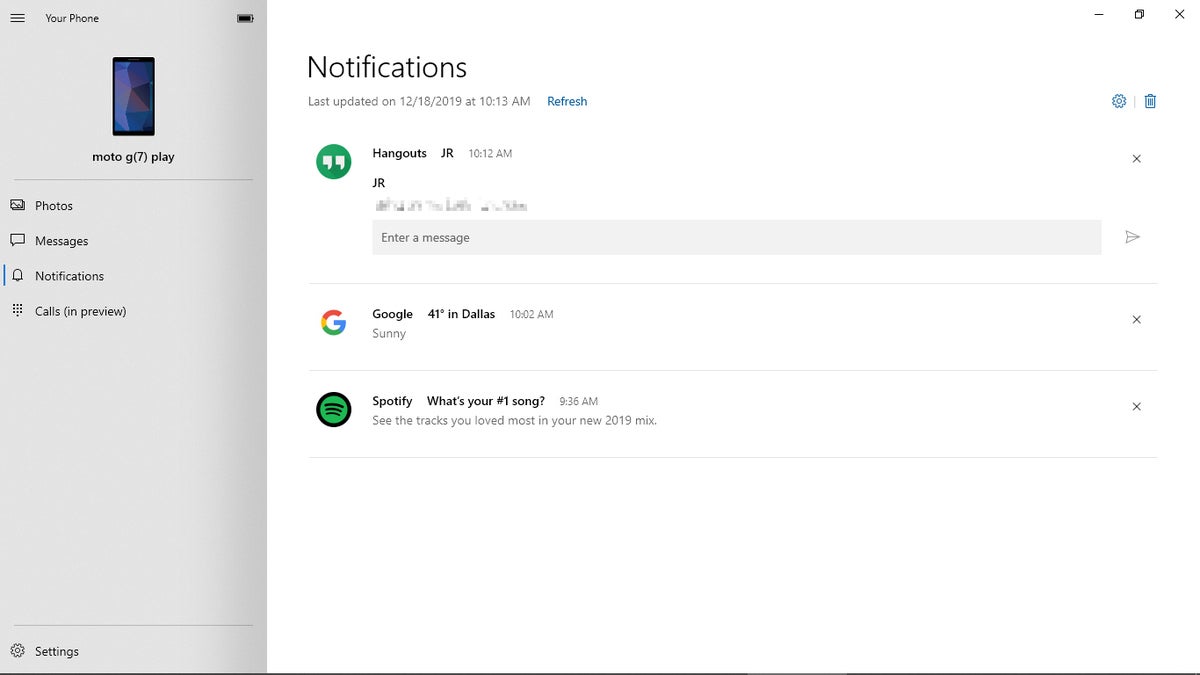 IDG
IDG Using the Your Phone app on your Windows 10 PC, you can view notifications and reply to text messages that your Android phone receives.
To choose the apps on your Android phone that you want to send notifications to on your Windows 10 PC, click the Settings icon in the lower-left corner of the Your Phone app. In the main panel, scroll down to Notifications and click "Choose which apps notify you." A list of all the apps on your Android phone that can send notifications will scroll down. You can click the switch by each app name to stop its notifications from being forwarded to your Windows 10 PC.
Finally, you can make a voice call by clicking the bottom button in the navigation bar, Calls. This feature, currently in beta, requires that your phone and PC be linked together through a Bluetooth connection, so that the Your Phone app can route your voice call to your phone.
6. Microsoft Launcher: Access your Windows 10 Timeline from your Android device
In Windows 10, Timeline is a record listing various things that you've done on your PC, such as opening documents and visiting websites. Click the Task View button in the taskbar to view this extensive history, which is organized by date. You can use Timeline to find a document or image you were working on or a web page you visited and access it again. (See "5 hidden Windows 10 features you should be using" for details about how to use Timeline.)
You can access your Windows 10 Timeline from your Android phone by installing the Microsoft Launcher app on it. Sign in to the app with your Microsoft user account and set Microsoft Launcher as your smartphone's default Home screen. Then from the Home screen, swipe left to the first screen.
On the bottom toolbar, tap the Timeline icon. A list of web pages you've recently visited on your Windows 10 devices appears. Tap an item to open that web page in your phone's web browser. If you have Office apps (Word, Excel, PowerPoint) installed on your phone, you can also use Timeline to open recently used documents in those apps. And if you open a document in an Office app on the phone, the document appears in the Timeline of a Windows 10 PC that's signed into the same user account.
 IDG
IDG You can access your web browsing history on your Windows 10 PC from your Android phone by using the Microsoft Launcher app.
7. Office Lens: Sync "scans" taken with your Android device to your Windows 10 PC
This nifty Office Lens app by Microsoft isn't specifically linked with Windows 10 but integrated with OneDrive. It's for capturing documents, which can include business cards and receipts, with your Android device's camera. (Microsoft likes to say you're scanning such items, presumably because you're capturing text, but all you do is take a photo normally.) You can also use the app to snap images of drawings, handwriting or text on chalkboards, whiteboards or signs.
 IDG
IDG When you snap a picture with Office Lens (left), the app automatically aligns, cleans up and crops the image before saving it to OneDrive (right).
Office Lens automatically aligns, cleans up and crops the captured image, and can convert it into editable text and graphics in OneNote, PowerPoint or Word format, or preserve its formatting as a PDF. The captured document image is automatically uploaded to your OneDrive folder (which you can, of course, then access on your Windows 10 PC).
Note: The OneDrive app for Android also comes with a tool that lets you capture documents, but it lacks the ability to change your phone's camera resolution to capture in a higher or lower image quality.
8. Microsoft Launcher or OneNote: Access, create, edit and manage your Sticky Notes from your Android device
On Windows 10, you can quickly create notes and to-do lists using the Sticky Notes app. There is no official Sticky Notes app for mobile devices. Instead, you can access your Sticky Notes, and also create, edit or delete them, through the Microsoft Launcher or OneNote app.
To use the Microsoft Launcher, install it and set it as your smartphone's default Home screen. Swipe left to the first Home screen and tap the Glance icon on the lower left of the screen. In the main screen, scroll down through the information cards until you see your Sticky Notes.
In OneNote, there's a Sticky Notes icon on the lower right of the main screen. Tap it to view a listing of your notes.
Notes that you create, edit or delete through either Android app are synced to the Sticky Notes app on your Windows 10 PC.
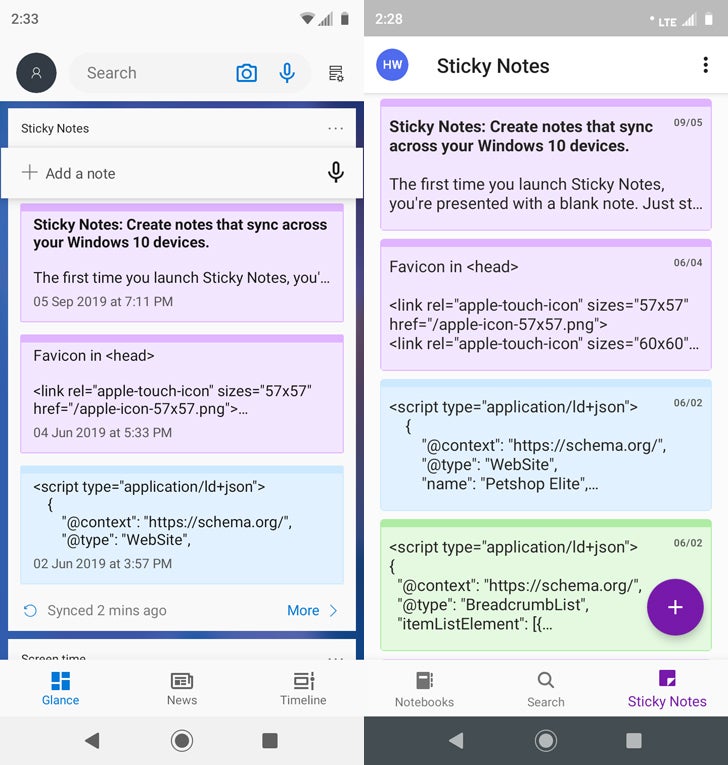 IDG
IDG You can use either the Microsoft Launcher or OneNote app for Android to access and manage your Sticky Notes that you created on your Windows 10 PC.
9. Microsoft Edge: Sync your browsing history between your phone and Windows 10
Once you sign in to it with your Microsoft user account, the Android version of Microsoft's web browser, Edge, will sync your bookmarks, history and other data from Edge on your Windows 10 PC to it. But why bother using Edge at all — especially if you're primarily browsing with Chrome on your PC?
First, it can be helpful to keep an alternative browser on your phone as a backup in case you encounter an issue with the Android version of Chrome. If you're already using Windows 10 in coordination with your Android phone, Edge is a natural backup choice.
Second, when you view a web page on your Android phone with Edge, you can forward that page directly to your Windows 10 PC and resume reading it in Edge on your PC. To do this, in Edge for Android, tap the middle icon that's toward the bottom of the app. A list of your Windows 10 PCs will appear. Tap the one that you want to forward the web page to. Then, on that PC, the Edge browser will automatically launch and load the web page you forwarded.
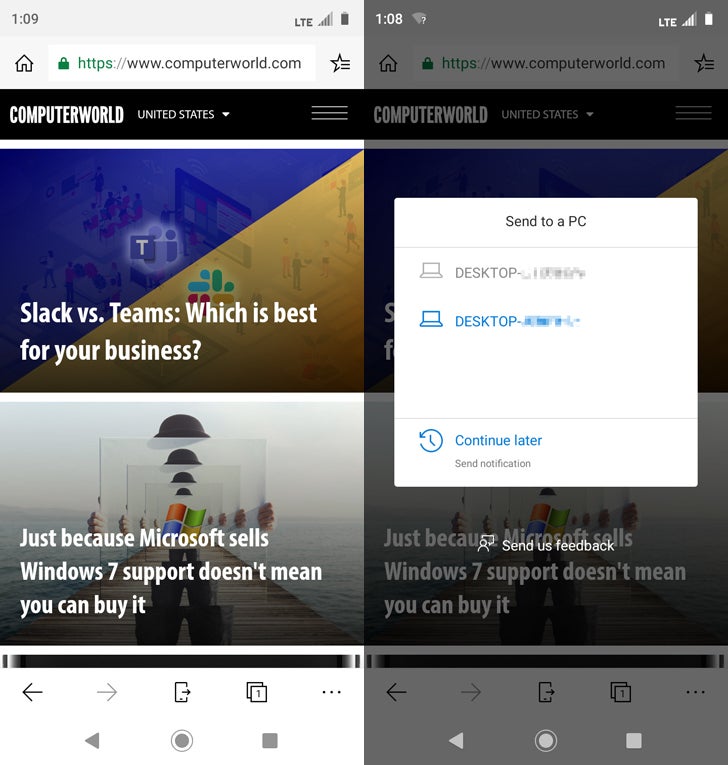 IDG
IDG With the Android version of Microsoft's browser Edge, you can forward a web page directly to your Windows 10 PC and continue viewing it on the Windows 10 version of Edge.
10. Microsoft Solitaire Collection: Play the classic Windows card game on your Windows 10 PC and Android device in sync
The classic Microsoft Solitaire game was rebooted for Windows 10 as a Windows app that includes five card games: Klondike, Spider, FreeCell, TriPeaks and Pyramid. You can connect the app to Microsoft's online gaming service, Xbox Live, to earn achievements, compete against other players, and share video clips of your gaming sessions.
Microsoft released an Android version of Microsoft Solitaire Collection that has all these features. You can even start a game on this app, stop playing, and resume it later on your Windows 10 PC — your game data and progress are saved and synced to the cloud through Xbox Live.
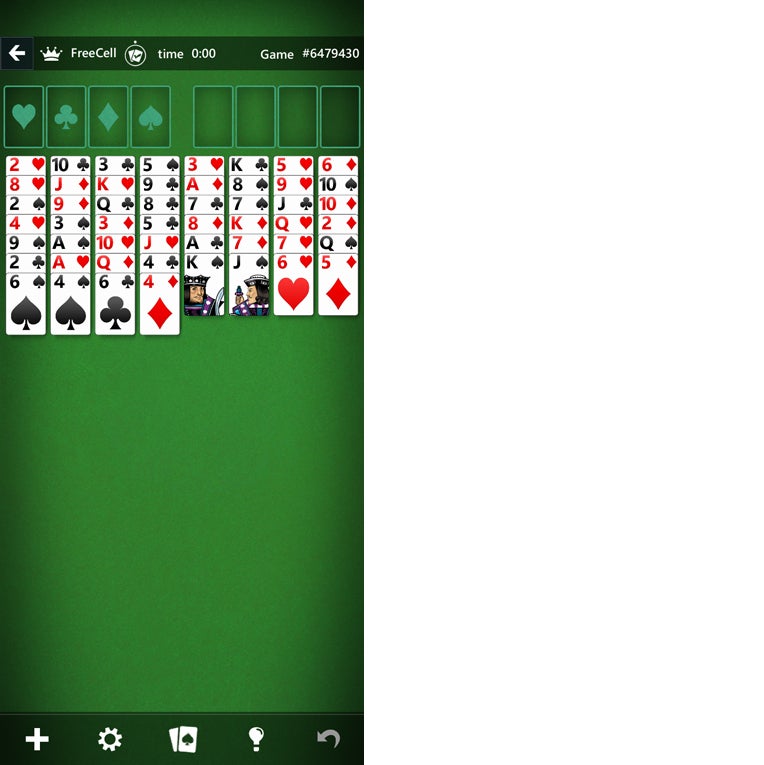 IDG
IDG You can start a game of solitaire on your Android phone and finish it later on your Windows 10 PC, thanks to Xbox Live syncing.
This story was originally published in April 2017 and updated in January 2020.
Read this next: How to create a complete Microsoft experience on Android
Howard Wen reports for several technology publications. His website can be found at www.howardwen.com.
Copyright © 2020 IDG Communications, Inc.
How to Get Simcity 4 to Work on Windows 10
Source: https://blogs.computerworld.com/article/3188392/10-ways-android-and-windows-10-can-work-well-together.html
0 Response to "How to Get Simcity 4 to Work on Windows 10"
Post a Comment